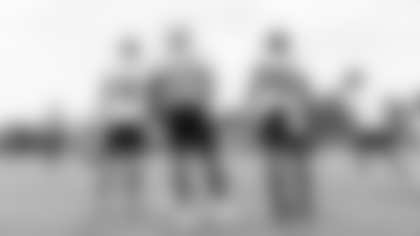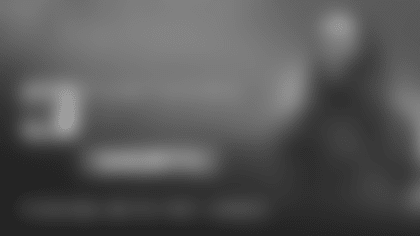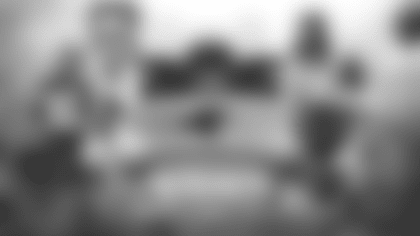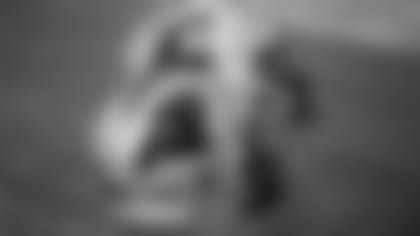Panthers right guard Austin Corbett suffered a torn left ACL on Jan. 8 in the regular season finale against the Saints. He has agreed to take us inside the rehab process, explaining his perspective on what coming back from the injury entails from a physical and an emotional standpoint and what the months of work to return actually look like as they're happening. This is his story, as it unfolds.
SPARTANBURG — On one hand, it's kind of lonely for Austin Corbett when his friends are all practicing and he's working by himself on a side field.
On the other hand, he can feel his hands.
So it goes for Corbett during the dog days of training camp, in which he's as much of a coach as a participant. That doesn't mean he hasn't made significant strides in his rehab from a torn ACL; it's just that the strides he's making don't look much like what the rest of them are doing.
So while the normal landmarks of camp aren't there for him, there are things he can do this summer that aren't usually part of his practice.
After a Super Bowl run with the Rams, a short offseason before a cross-country move, then 21 more games last year, he's not used to feeling good in all the other areas of the body other than his surgically repaired left knee.
Corbett kind of smiled and wiggled his fingers, realizing how fresh he actually felt in many ways.
"Like for me and all offensive linemen, your hands are always just destroyed," he said. "And so are your wrists, shoulders, hips, ankles, like everything else in between. I was just sort of thinking about it. And I'm kind of just like, this is the first time I'm able to do overhead press work in the weight room. I haven't been able to do that a bunch in years. The grip strength is just tremendously increasing, just because I can actually close my hands.
"There's points when you get into the season where you can't even open a water bottle, and your fingers just hurt so bad because you're just constantly abusing them. I know everybody's seen all the gnarly photos of ex-NFL linemen and their jacked-up fingers."
He's played enough football that he's not going to become a hand model or anything, but he is enjoying having feeling again. Asked how he gets through that less-serious medical issue in a normal year, he said you can dip your hands in paraffin wax — "and that can feel good for a little bit" — but the relief is temporary.
"Tuesday is always the worst day," he recalls of the usual patterns of pain. "Between Tuesday and Wednesday, just the mental side of going out there on Wednesday, and it's a full padded practice. You know, your hands just feel like glass. You've got to just figure out a way, cinch down the tape a little tighter, get some of the blood out of there, and not feel them.
"It's awful. It's so hard to put in words what it does to your hands. And there's so very little you can actually do. It's not a crazy musculature. There's not a treatment. You can't really rehab it. But this time has been incredible for the hands."
Of course, the hands are the least of his concern at the moment, because there is a lot you can do for a knee, and he's doing it. And there are a lot of words to describe it, and he's reading them.
While it might look to fans on the hill like Corbett has it easier than the rest of the roster, his days may actually be longer and more strenuous in their own way. Because rehabbing a torn ACL comes with the physical burden of restrengthening your legs and getting them back into balance, along with the mental workload of watching all the same film and helping your teammates on the practice field. But it also comes with the bonus of the emotional toll of watching someone else do your job and not being able to do much about it.
His second family — the team's athletic training staff — sees it all, and how he's handling it.
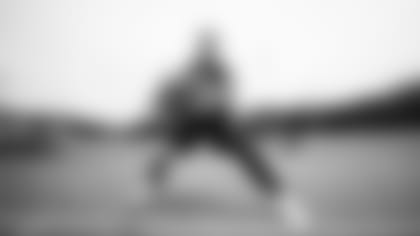
Assistant athletic trainer Katy Rogers, who probably deserves a seat the Thanksgiving table with the Corbetts this fall, is there for the long hours.
She sees him come in early for treatment. She sees the lifting, the straining. And then, after his on-field work is done, she sees him back on a training table, reading research studies about anatomy and kinesiology and all the associated science (Corbett considered medical school before he realized how good he was at football).
And then, when he's finished for the day, he'll often clean up his own area, and wipe down the table he's been sitting on.
"It's like, Austin, we've got this," Rogers said with a laugh.
"It is a long uphill battle at times during training camp, but it's to ramp you up," Rogers continued. "And I think sometimes people see him at practice not doing what everyone else is doing, right? But they're not noticing that his day starts earlier and ends a little bit later.
"So his contribution, he wants to be there for practice. He wants to coach with his teammates. He wants to use his football IQ. But he is in here a lot."
He's doing what he can when he can because that's the only way to approach it. His conscientious approach is consistent with what he's done throughout, whether it's treatment or his diet or sleep schedules, all the elements that go into a successful rehab.
So while head coach Frank Reich mentioned something the other day about Corbett being "ahead of schedule," the reality of rehab is that you don't measure time that way. He has to keep the focus narrow, which means small steps.
"He's where he needs to be," head athletic trainer Kevin King said with a grin, because that's all the update that actually matters in the world of recovering from such a significant injury.
But when Corbett's on the field alone, he's still making big strides.
He was recently cleared for change-of-direction drills by his surgeon, Dr. Neal ElAttrache. That's a big step from a month ago when he was cleared to run in a straight line, and quickly forgot how much he doesn't love running.
"Yeah, a little of this," Corbett said with a grin, dancing a little jig and clearly enjoying his newfound agility.
Now, he can do something resembling the individual drills offensive line coach James Campen puts his peers through.
Rogers calls the first steps "non-reactive drills." In a half-squat over an exercise ball, Corbett might take three steps to the left and then three to the right to simulate a pass-protecting motion. Eventually, those drills will become reactive, and someone will point in one direction, and he'll respond by going that way. But now, the steps are prescribed.
"It's a nice progression," Rogers said. "Eventually, we'll put him up against a person that is smaller (for now it's sports science coordinator Ryan Bellerose), and then we'll build into a defensive lineman-sized person, so he does get a little contact.
"It's truly amazing to watch his progression. But the biggest thing is, you have to put him in situations that he's going to be in and be honest about it. His coaches have been very eager to help as well and give us cues on how to educate him."
That means Rogers and the other staffers will offer football-specific cues like dragging toes or moving hands a certain way.
"So it's not just about OK, can he hit top speed? Yeah, great. But he's an offensive lineman; how often does he need to be doing that?" Rogers said. "His is more technical or power-based work. So I think he's extremely excited to get a little bit more hands-on into that."
When he runs and cuts, they'll start at 30 degrees, working up a little at a time, planting and cutting. They'll add to the angle. They'll add weight for resistance. But that will take time.

So until he can do the bigger thing, he does the small steps, as he has for seven months now. That extends to meal times, as well. He's working with director of performance nutrition Kate Callaway because he needs to add bulk. Since he's basically a powerlifter at this point, he needs to fuel the machine, so he can build back the mass he's lost in his (relative) inactivity.
Before he could lift as aggressively as he is now, he'd lean heavily into proteins and vegetables and avoid carbohydrates to keep from gaining bad weight.
Now, he needs carbs before workouts and carbs and proteins after to keep the muscle-building apparatus at its peak.
It's a small point, but an example of the level of detail Corbett and others have in this process. It's also an example of how many people in the building are helping him through this process. It takes a village to get Corbett back on his own two feet.
And yet, they don't mind. One, it's the job. But Corbett's character and maturity are such that he appreciates their help, helps them where he can, and tries to do what he can for others.
"His interpersonal skills are strong, and even with interns, he connects with people and cares about people, engages with people," Rogers said.
"He's very present," King added.
There are still weeks before he'll be back to anything resembling normal, such that anything is normal anymore. For all the lifting he's done, they're getting closer to his reconstructed left leg being roughly as strong as the healthy right leg. But as he lifts, the right one keeps getting stronger, so they're chasing those gains.

In a little over a week, they'll have another call with Dr. ElAttrache. While these stories have been coming out at monthly intervals from the date of the injury, the doctor measures the time from the surgery. So at seven months post-procedure (the 18th), there's the possibility of a little bit more coming his way.
Corbett never looks too far beyond his shoes for fear of the distance to the destination overwhelming him. But somewhere in the near distance, there might be a blocking sled in his future that he gets to drive into with his full weight — to exert some force rather than just react to it.
Before he gets there, it's a step at a time, with the constant enemy of boredom lurking around the corner. He's putting in a lot of hours, but he's not practicing. So Rogers and King have made sure he takes the days off, too, so he can go home and see his wife and family. They'll push the training back later in the day to make sure he's fresh.

"He's putting in so much work. He deserves the off day, too," Rogers said. "So what he'll do is he'll go home, spend the night at home, see the kids when they wake up. And then we'll train later in the day.
"We want to make it work. So he's physically doing what he needs to do, but also being a dad. That's good for him."
So is the simple act of being around teammates. During practice, he'll coach up his replacement Cade Mays; he'll talk through protections with the guy he's normally next to, Taylor Moton.
He'll stand alongside Campen and help where he can.
It's not what he wants to be doing.
But he's closer than he's been. And that matters.
"There's enough going on for me here, right?" Corbett said with a laugh. "You can keep yourself entertained down here."
And if he needs to call his wife for a little moral support, he can also pull his phone out of his pocket and dial it himself since his hands actually work.
It's the little things.





